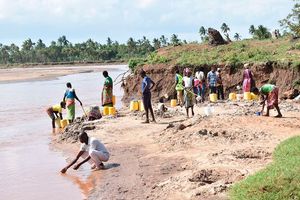From 'curse' to cure: How Kwale has managed to contain elephantiasis

Ali Jabiri before surgery.
What you need to know:
- Lymphatic filariasis, also known as elephantiasis, is a neglected tropical disease caused by thread-like parasitic worms transmitted through mosquito bites.
When Ali Jabiri, a resident of Lunga Lunga in Kwale County, first noticed swelling in his legs and genitals at the age of 35, he thought he had been cursed. For five years, he endured pain, shame, and desperation—visiting traditional healers, trying herbs, and even performing rituals—but his condition only worsened.
It was not until 2020 when he met a community health promoter during an outreach visit in his Miungoni village, that he discovered the truth.

Ali Jabiri after a successful surgery.
The health promoter revealed that Ali was suffering from lymphatic filariasis, a parasitic disease spread by mosquitoes.
Lymphatic filariasis, also known as elephantiasis, is a neglected tropical disease caused by thread-like parasitic worms transmitted through mosquito bites. Once inside the body, the larvae travel to the lymphatic system, where they develop into adult worms, blocking drainage of lymph and causing painful, disfiguring swelling—especially in the legs, arms, and genital areas, notes the World Health Organization.
“I had never heard of it. But the health worker told me that if I went to hospital, there was a chance I could get better. That is when I found hope," he says.
Ali was referred to Msambweni County Referral Hospital, where he underwent a hydrocelectomy—a surgical procedure to remove the fluid-filled swelling that had developed in his scrotum, a common complication of the disease.
Today, he walks upright, his confidence has been restored, and he now speaks openly about his experience to help others.
“I wasted five years of my life because of misinformation. I don’t want others to go through the same,” he says.
Ali is among the 365 elephantiasis patients who have so far undergone successful surgery at various public hospitals across the county, according to Kwale health records.
County Neglected Tropical Disease Coordinator Mohammed Mwachinangu said they had 800 cases that needed to undergo surgery but due to limited infrastructure, they have only done 365 procedures.
“We plan to perform 80 per cent of the surgeries by the end of this year,” said the health official.
Mr Mwachinangu said the county is on the verge of eliminating elephantiasis, with health officials reporting an impressive 98 per cent success rate in combating the disease.
This achievement is attributed to sustained mass drug administration, increased community awareness, and improved healthcare services.
He confirmed that seven rounds of mass drug administration had been carried out, primarily targeting school children.
“A recent survey that focused on school-going children showed that 90 per cent of those tested were negative. The disease remains in only a small percentage of the population, particularly in Mrera village - at less than one per cent,” said Mr Mwachinangu.
Complete elimination
She added that they are planning targeted drug administration in the area to ensure complete elimination.
Health authorities have also mapped affected regions and trained healthcare workers to provide home-based care for patients with elephantiasis.
Mr Mwachinangu attributed the success to the Ministry of Health and African Medical Research Amref.
Additionally, Amref has supported surgical interventions for those with advanced cases of the disease.
However, Mr Mwachinangu acknowledge that infrastructure challenges are slowing down the final phase of the fight against the disease.
Limited number of operating theatres has forced doctors to compete for space with emergency cases, including caesarean sections. In some areas such as Lunga Lunga, the male hospital ward has developed cracks, making it impossible to admit patients after surgery.
“These issues have affected our progress, but we are encouraged by the tremendous gains we have made. The disease is almost wiped out, and we are determined to see it eliminated completely,” the official stated.
Cultural beliefs had previously hindered efforts to tackle elephantiasis, with many residents attributing the disease to witchcraft.
However, through extensive awareness campaigns, these myths have been debunked, leading to increased acceptance of treatment.
With the final phase of eradication in sight, health officials are urging residents to remain vigilant and continue participating in treatment and prevention programmes.
According to the Ministry of Health, the disease remains endemic in several coastal and western regions including Kwale, Kilifi, Tana River, and parts of Busia.
According to the World Health Organization, over 120 million people are infected with lymphatic filariasis globally, with nearly 40 million suffering from the severe form of the disease.
In Kenya, thousands are still at risk, but progress is being made. The country hopes to eradicate the disease by 2027.
For individuals like Jabiri, surgery has been life-changing.
“I can now work, farm, and go to the market without hiding. I feel like a human being again,” he says.


